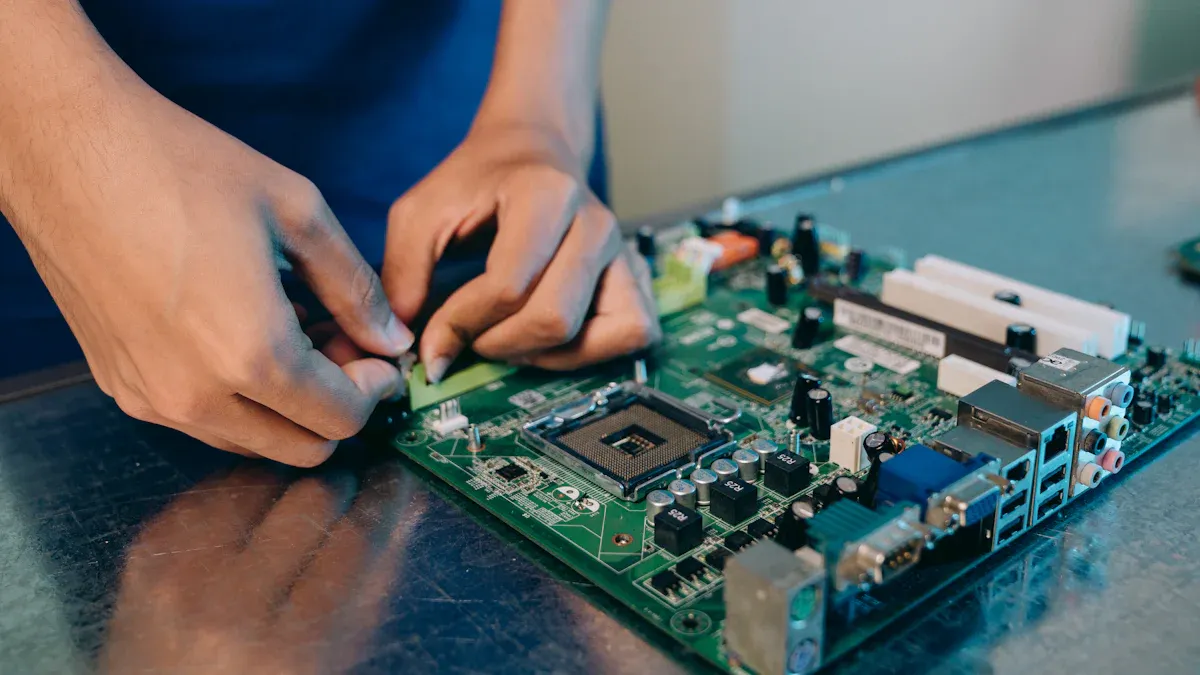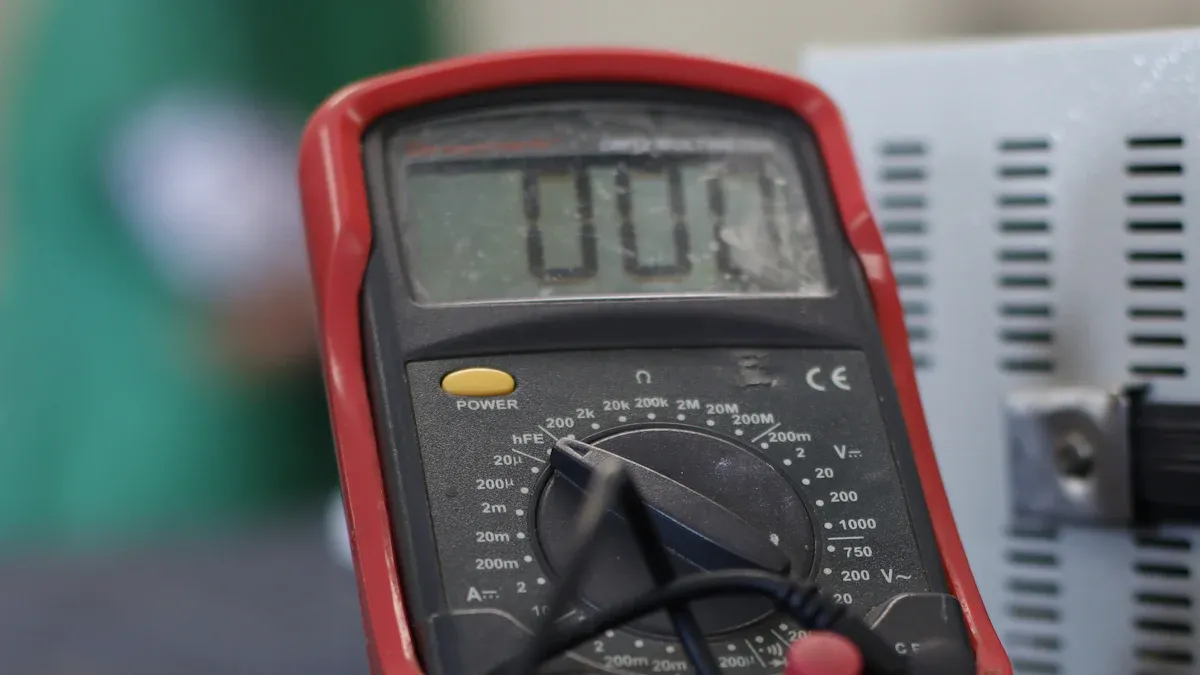How Impedance Control Improves Signal Integrity in PCB Manufacturing

Impedance control is very important for keeping signals clear in PCB making. Without it, fast PCB designs can have weak signals, lost data, or even stop working. Things like USB 3.0, Ethernet, and RF circuits need exact impedance to stop signal bouncing and work well. This is extra important in cars, medical tools, and telecom systems, where safety and reliability matter a lot. Focusing on impedance control helps your designs work better and stay safer.
Ignoring impedance control in fast systems can cause signal problems, lost data, or big failures.
Key Takeaways
Impedance control helps keep signals clear in fast PCB designs. It stops problems like signal bouncing and losing data.
Picking good materials and stack-up setups in PCB design improves signal quality and performance a lot.
Using new design tools and smart ways to route traces helps control impedance, making sure PCBs work well.
The Role of Impedance Control in Signal Integrity

What is impedance control in PCB design?
Impedance control means managing how signals flow in a PCB. Signals face resistance, capacitance, and inductance as they move. These can weaken or change the signals. Impedance control keeps these effects in check. This helps signals travel smoothly without problems.
To understand this better, look at these standards:
Source | Description |
|---|---|
Rules for PCB design, making, and assembly, including impedance control. | |
NASA High-Speed PCB Design Guide | Tips for controlling impedance in fast PCB designs. |
These rules help ensure precise impedance control. This is very important for today’s electronics.
Why is impedance control essential for high-speed circuits?
Fast PCBs need quick and clear signal movement. Small impedance problems can cause big issues. Without control, signals may reflect, mix, or get lost. This can hurt devices like USB 3.0, Ethernet, and RF circuits.
In fast PCBs, signals act like waves, not just currents. If impedance changes, waves can bounce back and cause interference. Controlling impedance stops this and keeps signals clear. This protects your design’s performance.
How LT CIRCUIT ensures effective impedance control in its PCB products
LT CIRCUIT focuses on impedance control in every PCB step. They use advanced materials and methods to keep impedance steady. With modern tools, they calculate impedance accurately. This ensures each PCB meets the needed standards.
LT CIRCUIT also offers custom solutions for your needs. Whether you need multilayer or HDI boards, they optimize impedance control. Their focus on quality makes them a reliable choice for fast PCB designs.
Key Factors That Affect Impedance in PCB Design
How materials affect impedance
The materials used in a PCB are very important. They change how signals move through the board. For example, PTFE is great for RF circuits because it affects impedance. Ceramics change dielectric properties, which impacts signal quality. Rogers materials are popular for 5G because they keep impedance steady.
Here’s a simple material comparison:
Material Type | Effect on Impedance |
|---|---|
PTFE | Used in RF circuits, changes impedance behavior. |
Ceramics | Alters dielectric properties, affecting signal quality. |
Rogers Material | Best for 5G designs, keeps impedance consistent. |
Picking the right material helps signals stay clear and fast.
Trace size, spacing, and shape
The size, space, and shape of PCB traces matter a lot. Wider traces lower resistance, while narrow ones raise it. Traces too close together can cause crosstalk, which mixes signals. Straight or curved traces also change how signals flow. Balancing these factors keeps signals smooth.
Why stack-up and layers are important
The way PCB layers are arranged affects impedance control. A good stack-up lowers noise, crosstalk, and EMI. For example, a 4-layer stack-up with ground-signal-signal-ground layers gives a low-impedance path. Adding more layers, like in 6-layer or 8-layer boards, improves signal quality and EMI control.
Here’s a look at common stack-ups:
PCB Stack-Up Configuration | Description | Effects on Signal Performance |
|---|---|---|
4 Layer: Signal-Ground-Power-Signal | Basic setup with ground and power layers. | Lowers noise and crosstalk, works for most uses. |
4 Layer: Ground-Signal-Signal-Ground | Two signal layers between ground layers. | Gives low-impedance path, reduces crosstalk. |
6 Layer | Adds extra ground and power layers. | Better EMI control and signal quality. |
8 Layer | Signal layers split by power and ground planes. | Cuts crosstalk, boosts signal quality. |
Choosing the right stack-up helps your PCB handle fast signals better.
Practical Strategies for Achieving Impedance Control

Design tools and software for precise impedance calculation
To control impedance well, you need the right tools. Modern software makes this easier and more accurate. Here are some helpful tools:
PCB Design Software: These programs have built-in calculators for impedance and stack-ups. They help with high-speed PCB designs.
Dedicated Impedance Calculators: These tools, online or standalone, calculate impedance using trace size and materials.
Electromagnetic Field Solvers: These advanced tools analyze impedance and simulate electromagnetic effects in your PCB.
Signal Integrity Analysis Tools: These combine impedance checks with signal tests to find and fix problems.
Measurement Equipment: Devices like TDRs and VNAs check impedance during production to meet design needs.
Using these tools helps your PCB keep signals clear and work well.
Best practices for trace routing and layout optimization
Good trace routing and layout improve impedance control. Follow these tips to make your PCB better:
Keep important traces away from noisy parts to avoid problems.
Space traces properly to stop signals from mixing.
Run fast signals over ground planes for steady impedance.
Use soft 135-degree bends, not sharp 90-degree turns, to avoid reflections.
Place parts smartly to shorten trace paths and improve flow.
Make signals go in the same direction to keep traces short.
Adjust trace shapes and use proper ends to keep signals strong.
These steps help your PCB handle fast signals while keeping quality high.
Collaborating with LT CIRCUIT for customized impedance control solutions
Working with LT CIRCUIT gives you custom impedance solutions. They use advanced tools and materials to match your design needs. Whether you need multilayer boards or dense designs, they optimize for speed.
LT CIRCUIT also guides you through design and production. Their team helps calculate impedance, pick materials, and plan stack-ups. They focus on quality, so your PCB will perform reliably.
By partnering with LT CIRCUIT, you get a trusted team to ensure your designs have great signal integrity.
Checking Impedance Control During PCB Manufacturing
Ways to Test Impedance in PCB Production
Testing makes sure your PCB works as planned. It also keeps signals clear. Different methods are used to check impedance during production. Each method works best for certain needs:
What It Does | Best Use Cases | |
|---|---|---|
Flying-probe test | Uses small needles to test board parts. | Great for small batches. |
In-circuit test (ICT) | Uses fixed programs to test finished boards. | Best for large batches. |
TDR (Time Domain Reflectometry) | Checks impedance and signal quality at test points. | Good for detailed signal checks. |
For better results, test both sides of components. Use 4-wire testing for resistors under 100 Ohms. Capacitors with small values can be tested with 0.1% accuracy.
Tools That Help Check Impedance
Advanced tools are key for checking impedance. TDR is often used to measure impedance and find signal problems. It gives exact data about signal quality. Another tool, VNA, checks how your PCB handles different frequencies. These tools make sure your PCB meets performance needs.
Using these tools early helps find and fix problems. This keeps your PCB reliable and high-quality.
How LT CIRCUIT Meets Design Needs
LT CIRCUIT uses top tools and strict tests to meet your design needs. Their team uses TDR and VNA to check impedance and signal quality during production. They follow strict rules to meet industry standards.
With expert skills and modern tools, LT CIRCUIT makes PCBs that work well in fast systems. Their focus on accuracy ensures your PCB has strong signal integrity.
Impedance control is key to keeping signals clear in fast PCBs. It reduces signal issues and power changes in high-frequency uses. By seeing PCB traces as signal paths and matching impedance, signals stay strong and clear. LT CIRCUIT provides trusted solutions made just for your needs.
FAQ
What happens if impedance control is ignored in PCB design?
Skipping impedance control can cause signals to bounce back. This may lead to lost data or mixed-up signals. It makes fast devices less reliable and slower.
How does LT CIRCUIT ensure precise impedance control?
LT CIRCUIT uses modern tools and top-quality materials. They test with tools like TDR and VNA to check signal paths. This ensures your PCB works as planned.
Can impedance control improve PCB performance in all applications?
Yes, it helps signals stay clear and reduces noise. This is very important for telecom, cars, and medical devices.
See Also
Enhancing PCB Production Yield With Online Aoi Technology
Three Major Advantages Of Using VIPPO For PCB Design
Impact Of LDI Technology On PCB Product Quality
